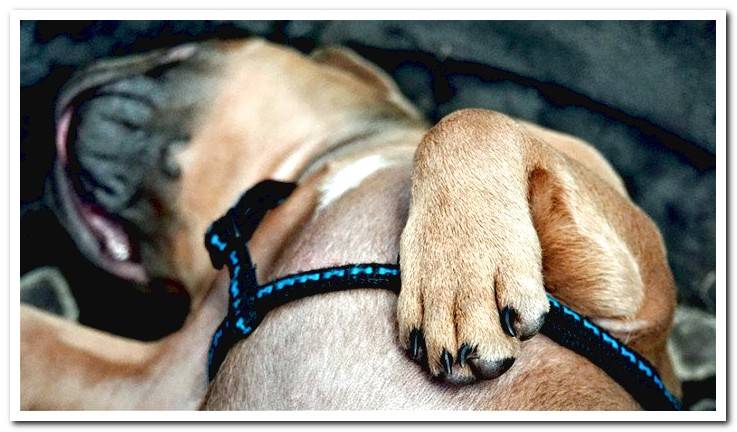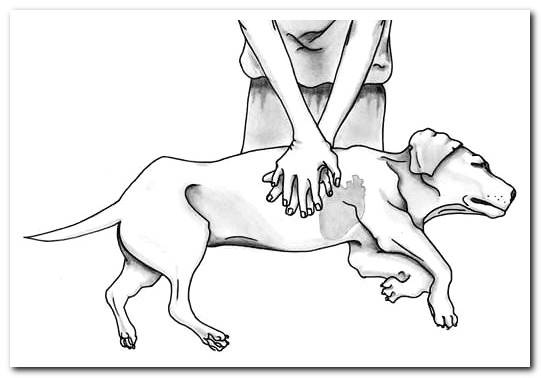
With CPR we refer to cardiopulmonary resuscitation. It is a maneuver that is started to try to recover, in this case a dog, its ability to breathe and beat.
Of course, it is a procedure that will be performed only in emergencies while we wait for the veterinaryn’s arrival or we move to a clinic. Doing it correctly will make the difference between life and death for our dog. Do you want to learn to do CPR? We explain everything in detail.
Index of contents
- 1 Rescue breathing vs. CPR
- 2 Situations that require CPR
- 3 How do I know if I have to do rescue breathing or CPR?
- 4 How to do rescue breathing
- 5 CPR on puppies and small dogs
- 6 CPR in medium and large dogs
- 7 The Success of CPR
Rescue breathing vs. CPR
Although the terms are sometimes used as synonyms, it is convenient to distinguish between the two techniques, which have in common that they are carried out in truly urgent situations. Artificial respiration or ventilation or rescue breathing is the procedure that aims to restart breathing in an unconscious dog that is not breathing on its own.
Instead, CPR is a rescue breath that is combined with cardiac massage because it is impossible for us to hear or feel the heartbeat. Normally, this last, more complete technique should be used, because when breathing stops, it is usual that, in a short time, the heart also stops.
If it is this organ that stops beating first, then breathing usually stops as well. Learning to perform these maneuvers is crucial because a dog without a heartbeat or breath is at imminent risk of death.
Situations that require CPR
The examples below are the ones that usually require us to apply the resuscitation technique. This can only be done by one person, although it would be better and more successful if there were two. Thus one will be responsible for breathing and the other for cardiac massage. They are the following cases:
- Shock.
- Poisonings.
- Epileptic seizures that do not subside.
- Eat.
- Significant trauma to the head.
- Electric shock.
- Choking or suffocation.
- Heart attack.
How do I know if I have to do rescue breathing or CPR?
The first thing to keep in mind is that, normally, caregivers are not health personnel. This means that our first option, when facing a stopped dog, should be to contact the vet. Only if it is at a considerable distance will we have to act.
Then we have to look at whether the dog is breathing or not. For this we will observe if the chest rises and falls or we will put our hand to the nose to notice if air comes out. Then we will look for the pulse. It is possible to locate it inside the thigh, where the femoral artery is located.
If there is neither pulse nor breathing, the maneuver of choice will be CPR. With pulse what is chosen is rescue breathing. CPR is done differently depending on whether we are dealing with a small or large dog.
How to do rescue breathing
To do a correct CPR we have to know how to perform rescue breathing as well. It is essential because CPR includes artificial respiration and cardiac massage. It is done by following these steps:
- Catch the dog’s tongue between your fingers and pull forward.
- Close your mouth.
- Put our mouth on the dog’s nose.
- Blow gently.
- If we do it right, the chest has to expand.
- We remove our mouth. In medium and large dogs, the dog’s mouth is kept closed as tightly as possible, wrapping our hands around the muzzle.
- 20-30 breaths are made per minute.

CPR on puppies and small dogs
By small dog we mean those specimens weighing less than about 15 kg. In these cases, or when we have to resuscitate a puppy, The steps to follow are those:
- Lay the dog flat on its right side.
- Place our hands one on each side of the rib cage and over the heart. The exact point is below the peak of the elbow.
- If it is a very small puppy, the thumb is positioned on one side and the rest of the fingers on the other.
- Compress the chest approximately 1 / 4-1 / 3 of its full width.
- Press while counting one and release, also counting one.
- The rate is 100 compressions per minute.
- Every five compressions a rescue breath is made.
CPR in medium and large dogs
From 15 Kg. Of weight, we can consider that a dog is medium or large and we must apply another methodology to practice CPR. You have to follow these steps:
- The dog of more than 15 kg is placed the same as a smaller one.
- We stand behind his back.
- We place the base of our hand over the widest area of the chest, not above the heart.
- We place the base of the other hand on the first.
- We straighten our elbows.
- We push vertically on the thorax.
- We compress between 1 / 3-1 / 4 of the width of the thoracic cavity.
- As in small dogs, we compress and release counting one in each action.
- The rate is 80 compressions per minute.
- Every five compressions a rescue breath is performed.
The Success of CPR
In a matter of minutes, with a well-done CPR, it is possible to get the dog to catch its breath and heartbeat. But not always achieved. If after ten minutes of effort the dog does not respond, unfortunately it will have died.
On the other hand, sometimes the manipulation of CPR has side effects. The most common are rib breaks and pneumothorax, in which case the air is located outside the lung.
